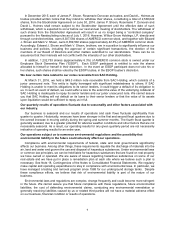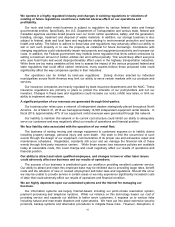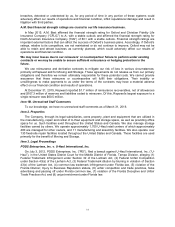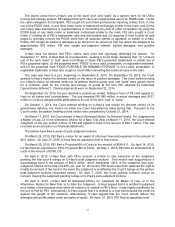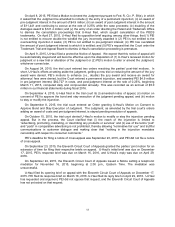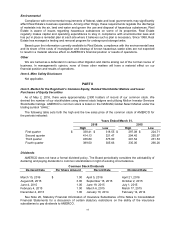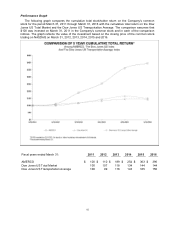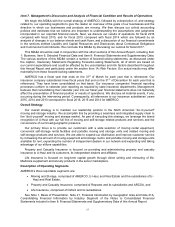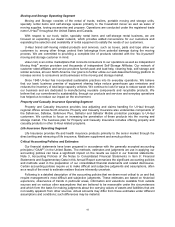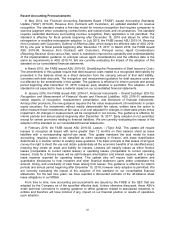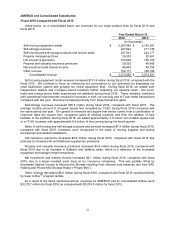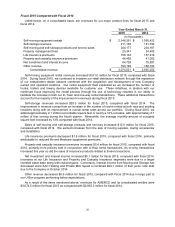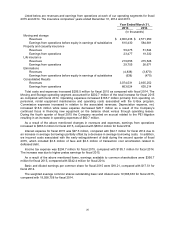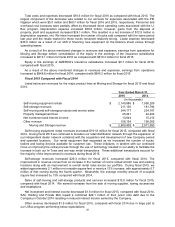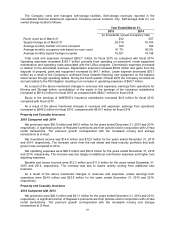U-Haul 2016 Annual Report Download - page 25
Download and view the complete annual report
Please find page 25 of the 2016 U-Haul annual report below. You can navigate through the pages in the report by either clicking on the pages listed below, or by using the keyword search tool below to find specific information within the annual report.19
We also have other policies that we consider key accounting policies, such as revenue recognition;
however, these policies do not meet the definition of critical accounting estimates, because they do not
generally require us to make estimates or judgments that are difficult or subjective. The accounting
policies that we deem most critical to us, and involve the most difficult, subjective or complex judgments
include the following:
Principles of Consolidation
We apply ASC 810 - Consolidation (“ASC 810”) in our principles of consolidation. ASC 810 addresses
arrangements where a company does not hold a majority of the voting or similar interests of a variable
interest entity (“VIE”). A company is required to consolidate a VIE if it has determined it is the primary
beneficiary. ASC 810 also addresses the policy when a company owns a majority of the voting or similar
rights and exercises effective control.
As promulgated by ASC 810, a VIE is not self-supportive due to having one or both of the following
conditions: (i) it has an insufficient amount of equity for it to finance its activities without receiving
additional subordinated financial support or (ii) its owners do not hold the typical risks and rights of equity
owners. This determination is made upon the creation of a variable interest and is re-assessed on an on-
going basis should certain changes in the operations of a VIE, or its relationship with the primary
beneficiary trigger a reconsideration under the provisions of ASC 810. After a triggering event occurs the
facts and circumstances are utilized in determining whether or not a company is a VIE, which other
company(s) have a variable interest in the entity, and whether or not the company’s interest is such that it
is the primary beneficiary.
We will continue to monitor our relationships with the other entities regarding who is the primary
beneficiary, which could change based on facts and circumstances of any reconsideration events.
Recoverability of Property, Plant and Equipment
Our Property, plant and equipment is stated at cost. Interest expense incurred during the initial
construction of buildings and rental equipment is considered part of cost. Depreciation is computed for
financial reporting purposes using the straight-line or an accelerated method based on a declining
balance formula over the following estimated useful lives: rental equipment 2-20 years and buildings and
non-rental equipment 3-55 years. We follow the deferral method of accounting based on ASC 908 -
Airlines for major overhauls in which engine and transmission overhauls are currently capitalized and
amortized over three years. Routine maintenance costs are charged to operating expense as they are
incurred. Gains and losses on dispositions of property, plant and equipment are netted against
depreciation expense when realized. Equipment depreciation is recognized in amounts expected to result
in the recovery of estimated residual values upon disposal, i.e., minimize gains or losses. In determining
the depreciation rate, historical disposal experience, holding periods and trends in the market for vehicles
are reviewed.
We regularly perform reviews to determine whether facts and circumstances exist which indicate that
the carrying amount of assets, including estimates of residual value, may not be recoverable or that the
useful life of assets are shorter or longer than originally estimated. Reductions in residual values (i.e., the
price at which we ultimately expect to dispose of revenue earning equipment) or useful lives will result in
an increase in depreciation expense over the remaining life of the equipment. Reviews are performed
based on vehicle class, generally subcategories of trucks and trailers. We assess the recoverability of our
assets by comparing the projected undiscounted net cash flows associated with the related asset or
group of assets over their estimated remaining lives against their respective carrying amounts. We
consider factors such as current and expected future market price trends on used vehicles and the
expected life of vehicles included in the fleet. Impairment, if any, is based on the excess of the carrying
amount over the fair value of those assets. If asset residual values are determined to be recoverable, but
the useful lives are shorter or longer than originally estimated, the net book value of the assets is
depreciated over the newly determined remaining useful lives.


